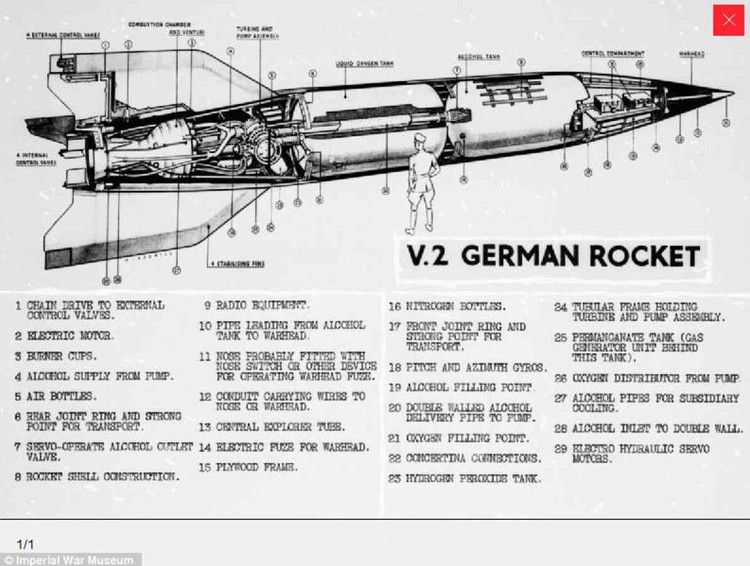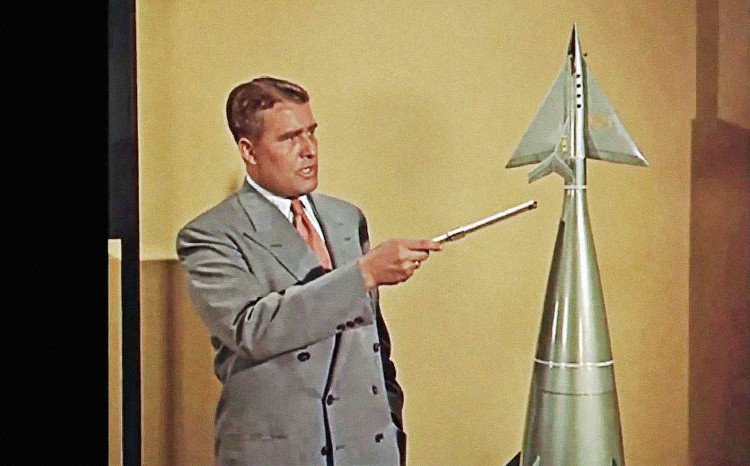Surprise with the 'ancestor' of all intercontinental ballistic missiles
The father of ballistic missiles is stunned when his powerful weapon is used to kill thousands of civilians in the UK.
Hitler's weapon

V-2 rocket design template.
London in the 1944s, the lives of people were extremely miserable after years of hardship during World War 2. In the early morning of September, when all the capitalists were sleeping, a strange object 'did not know bounced off and caused tremendous explosions , ' said James Comey, a witness at the time of the attack.
The sudden attack confirmed by the British army was carried out by the Nazis. However, the question is, what device did they use to attack when there was no "flying " plane in the sky of England at that time? Confusion and pessimism lasted many days later.
Not only England but other locations in Belgium also witnessed a fast-cutting attack of a strange weapon. The survivors only knew that the description was the black streaks that swung down from the sky and exploded like a bomb. The mystery of the German special weapon caused many people to not worry.
Father of ballistic missiles

The father of the V-2 rocket is the genius scientist von Braun.
On the other side of the battle line, the father of the special weapon and the destructive power is the rocket engineer Wernher von Braun . From a young age, von Braun cherished the dream of conquering the universe. He selected physics and applied mathematics in the hope that he would later become an outstanding rocket scientist.
Von Braun's wish to meet the needs of Adolf Hitler, the Nazi Chief of State signed a decision to create a destructive weapon to attack the Allies. After only 22 months of research, von Braun released the A-4 (later renamed the V-2 rocket engine) with outstanding breakthrough power. The V is implicitly Vengeance - revenge.

Von Braun and Walt Disney in America.
The British BBC channel in the 2011 documentary shows that more than 3,000 V-2 missiles have been built and shot into London. As a result, more than 9,000 civilians and soldiers in Britain were killed because of this terrible weapon.
The V-2 rocket was first shot in 1944 and proved its destructive power. The first ballistic missile in the world can fly from Germany, crossing the 320km route with supersonic speed. When it fell to the ground, it created some 20 meters deep and 10 meters wide. V-2 has enough power to knock 3,000 tons of stone bricks into the sky.
The only downside of the V-2 rocket at that time was that the production cost was very expensive while the more the end of the Great War, the more German money was scarce. Compared to bombers, V-2 does not cause effective damage. Normally, whenever the V-2 is targeted at London, the missile flies 10-20 miles farther than expected.

The city of London collapsed after being attacked by V-2 missiles.
Although the success of the V-2 missile achieved Hitler's wish, it made the engineer von Braun extremely upset. After learning that the London people died of weapons they built, he said: 'My missile is flying extremely accurately, only regret it flies to the wrong planet'. He also said he did not think that the desire to create space exploration missiles became a catastrophic murder weapon.
Platform for all types of ballistic missiles

V-2 missiles killed 9,000 British people.
Later, von Braun and some 1,600 other Nazi scientists and engineers fled to the United States and joined the Paperclip project (Paperclip). With the existing V-2 missile platform, he helped the United States get many outstanding advances in the field of spacecraft manufacturing and missiles. The first American Explorer 1 satellite or the Apollo Moon exploration program has the imprint of von Braun. He was awarded the National Medal of Science by the United States in 1975 and continued his mission of bringing people to Mars until his death.
As for the Soviet Union, after the Nazis were annihilated, they also obtained important information about the V-2 rocket and brought it back to the country. In the first phase, the Soviet Union focused on developing missiles to destroy targets in Europe.
Later in 1953, Sergei Korolyov was appointed director of the intercontinental ballistic missile program, but everything changed. The R-7 engine was built by the Soviet Union during this time, and in May 1957, the first Soviet intercontinental ballistic missile was launched but exploded after leaving the launch pad 400km.

Russia fired R-7 missiles.
Three months later, the Soviet Union successfully tested the missile and the device flew over 6,000 km. This is the first intercontinental ballistic missile in the world and in 1959, Russia's strategic missile unit was officially established. The base of this missile unit is in Plesetsk, northwestern Russia.
Thanks to the design of Nazi V-2 missiles, Russia successfully built and launched its first satellite. Sputnik satellite was launched into orbit in October 1957. The first human-orbital flight was made by the legendary Yuri Gagarin in 1961. The Soviet R-7 engine is still in use today and helped Russia achieve many important achievements in national technology. Space exploration and exploration.
- Russian intercontinental missiles were destroyed by human error
- Russia proposed using Satan missiles to destroy meteors
- American corporation makes ballistic missile components with 3D printers
- Top 10 most terrifying intercontinental missiles in the world
- Russian test ballistic missiles
- China is about to have nuclear missiles that can
- Discover Russia's unique 'unique' rockets once
- Russia launches the Dnepr cosmic boosters carrying 23 satellites
- Russia launches intercontinental ballistic missiles
- The shocking revelation of the terrible power of the Korean rocket
- Russia fired a test of intercontinental missiles
- How does Vietnam solve missile interception?
 'Fine laughs' - Scary and painful torture in ancient times
'Fine laughs' - Scary and painful torture in ancient times The sequence of numbers 142857 of the Egyptian pyramids is known as the strangest number in the world - Why?
The sequence of numbers 142857 of the Egyptian pyramids is known as the strangest number in the world - Why? Miracle behind the world's largest stone Buddha statue
Miracle behind the world's largest stone Buddha statue What is alum?
What is alum?